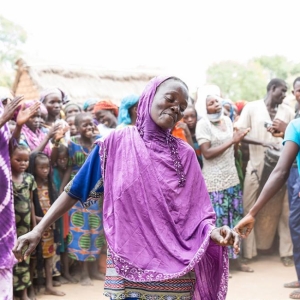Indicators in this domain assess the extent to which migrants have the same status as citizens in terms of access to basic social services such as health, education, and social security. It also describes the rights of migrants to family reunification, to work, and to residency and citizenship. The ratification of the main international conventions is also included within this domain.
Indicators in this category look at the extent to which migrants have access to certain social services such as health, education and social security. They also examine measures to ensure integration and access to work.
Indicators in this domain assess countries’ institutional, legal, and regulatory frameworks related to migration policies. Domain 2 also reviews the existence of national migration strategies that are in-line with development, as well as institutional transparency and coherence in relation to migration management. This domain also investigates the extent to which governments collect and use migration data.
Indicators in this category assess the institutional frameworks of cities for migration. This area also examines the existence of migration strategies consistent with development objectives, as well as institutional transparency and coherence in migration management.
This domain focuses on countries’ efforts to cooperate on migration-related issues with other states and with relevant non-governmental actors, including civil society organizations and the private sector. Cooperation can lead to improvements in governance by aligning and raising standards, increasing dialogue and providing structures to overcome challenges.
Indicators in this category focus on cities’ efforts to cooperate on migration issues with the national government as well as other cities and relevant non-governmental actors, including civil society organizations and the private sector.
This domain includes indicators on countries’ policies for managing the socioeconomic well-being of migrants, through aspects such as the recognition of migrants’ educational and professional qualifications, provisions regulating student migration and the existence of bilateral labour agreements between countries. Indicators equally focus on policies and strategies related to diaspora engagement and migrant remittances.
Indicators in this category assess cities’ initiatives in terms of international student mobility, access to the labour market and decent working conditions for migrant workers. Aspects related to diaspora engagement and migrant remittances are also included in this domain.
This domain studies the type and level of preparedness of countries when they are faced with mobility dimensions of crises, linked to either disasters, the environment and/or conflict. The questions are used to identify the processes in place for nationals and non-nationals both during and after disasters, including whether humanitarian assistance is equally available to migrants as it is to citizens.
Indicators in this category examine the type and level of readiness of cities to deal with aspects of mobility crises. The questions focus on the processes in place for citizens and non-citizens both during and after disasters, especially if humanitarian assistance is available for migrants and citizens.
This domain analyses countries’ approach to migration management in terms of border control and enforcement policies, admission criteria for migrants, preparedness and resilience in the case of significant and unexpected migration flows, as well as the fight against trafficking in human beings and smuggling of migrants. It also assesses efforts and incentives to help integrate returning citizens.
Indicators in this category look at the cities’ approaches to migrant safety as well as return and reintegration policies and the fight against trafficking in persons.
This country Profile describes examples of well-developed areas of the People’s Republic of Bangladesh’s (hereafter referred to as Bangladesh) migration governance structures and areas with potential for further development, as evaluated through the six domains of the Migration Governance Indicators (MGI). These address migrants’ rights, a “whole-of-government” approach, partnerships, socioeconomic well-being of migrants, the mobility dimensions of crises, and safe and orderly migration.
Click the icons on the wheel to explore the key findings.
The Migration Governance Indicators (MGI) initiative is a policy-benchmarking programme led by the International Organization for Migration (IOM) and implemented with research and analysis from the Economist Intelligence Unit. Funding is provided by IOM Member States.
Migration Governance: examples of well-developed areas
- Foreign residents with a work permit can accept any private-sector employment under the same conditions as nationals.
- Bangladesh has introduced and subsidized compulsory insurance schemes for Bangladeshi migrant workers.
- The Bangladesh Five-Year Plan (2016–2020) states that initiatives to accelerate growth and empower citizens must also include the Bangladeshi diaspora.
Areas with potential for further development:
- There are no clear rules on long-term residence for immigrants living in Bangladesh.
- Bangladeshi nationals currently living abroad are not able to vote in national elections.
Migration Governance: examples of well-developed areas
- A Steering Committee chaired by the Prime Minister and the National Migration Forum serve as interministerial coordination mechanisms on migration issues in Bangladesh.
- The Ministry of Expatriates’ Welfare and Overseas Employment has in place a strategy to ensure the sustainable and safe migration of female Bangladeshi workers.
- The Bureau of Manpower, Employment and Training has decentralized help desks available for nationals seeking to work abroad.
Areas with potential for further development:
- Bangladesh does not yet have a comprehensive database with relevant information on migrants and returnees nor a labour migrants information system.
Migration Governance: examples of well-developed areas
- Bangladesh is part of several Regional Consultative Processes (RCPs), namely the Abu Dhabi Dialogue, which includes countries where most Bangladeshi migrant workers are based.
- Bangladesh has signed bilateral labour agreements with Qatar and Kuwait and a number of memoranda of understanding related to migration issues with other countries.
- Civil society organizations are regularly engaged in national consultation processes on migration and development affairs.
Areas with potential for further development:
- Bangladesh is not involved in any regional agreement that promotes regional labour mobility.
Migration Governance: examples of well-developed areas
- Bangladesh has developed mechanisms to protect the rights of its nationals working abroad, including through pre-departure trainings.
- The government of Bangladesh together with the Central Bank actively promotes formal remittance schemes.
- The Expatriates’ Welfare and Overseas Employment Policy recommends that issues such as maintaining family ties be addressed, especially for family members of Bangladeshi migrant workers that are left behind
Areas with potential for further development:
- Bangladesh does not have a policy or formal mechanism in place to support the return and reintegration of migrants.
- National educational institutions limit the percentage of international students that can be enrolled.
Migration Governance: examples of well-developed areas
- The National Plan for Disaster Management addresses the return and reintegration of people displaced due to a climate-induced disaster.
- Humanitarian assistance is equally accessible to all, including migrants irrespective of their status.
- The Overseas Employment and Migrants Act provides for the emergency return of Bangladeshi nationals abroad in cases of humanitarian crises.
Areas with potential for further development:
- The National Strategy on the Management of Disaster and Climate Induced Internal Displacement does not contain specific measures to assist migrants or to address cross-border displacement.
Migration Governance: examples of well-developed areas
- The Wage Earners’ Welfare Board Act establishes a legal framework to promote improved welfare services for Bangladeshi migrant workers.
- The National Plan of Action for Prevention and Suppression of Human Trafficking focuses on providing economic and social assistance to victims of trafficking and people at risk, especially children.
Areas with potential for further development:
- Penalties under the Overseas Employment and Migrants Act for violations of some common ethical recruitment guidelines by recruitment agencies are relatively low.
2020 January




